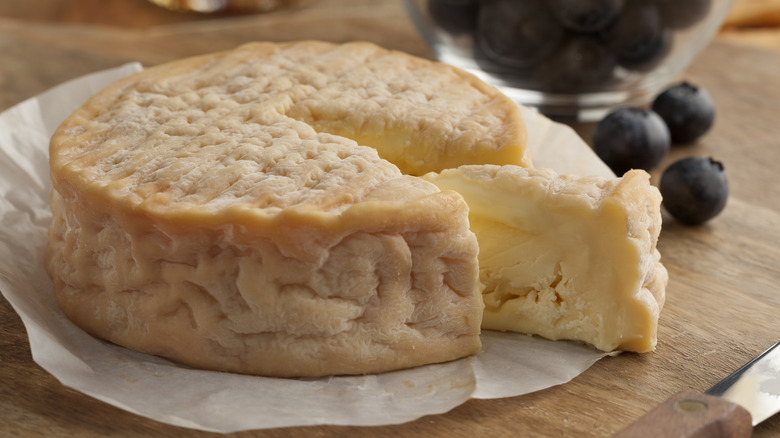What Makes Epoisses Cheese Smell So Pungent?
Epoisses has earned a reputation as one of the most aromatic cheeses in the world, and aromatic is really code for sort of stinky. While it's not quite as pungent as minger, the world's smelliest cheese, its aroma can be so strong that travelers in France have long joked about it being banned on trains and buses. But the intensity isn't random; it is intentionally funky as a direct result of the way this French classic is made. Epoisses belongs to the washed-rind cheese family, so instead of leaving the rind to dry and harden, cheesemakers bathe the exterior of an Epoisses wheel regularly during the aging process with brine and Marc de Bourgogne brandy. This deliberate "washing" creates the perfect environment for Brevibacterium linens, a bacterium that flourishes in damp, salty conditions. As it grows, it produces sulfur compounds, which are the same molecules behind horrid foot and body odors.
Those sulfur notes are what make Epoisses so immediately noticeable when you unwrap it. And even though it may be annoying, that unmistakable aroma is the marker of a living cheese that's actively developing flavor. The bacteria on the rind help break down proteins and fats in the paste, softening the interior and creating a gooey, spoonable texture. Therefore, the pungency is proof of the work happening beneath the surface; for cheese enthusiasts, that first waft when you open the door of your favorite specialty shop is a promise of complexity, signaling a cheese that's unapologetically all up in your face and deeply rooted in tradition.
Funky doesn't mean overwhelming
Aside from its formidable scent, the eating experience of Epoisses is far less intimidating than its aroma suggests. You're not going to gag or anything while trying to eat it. Washed-rind cheeses often have what could be described as a "bark worse than their bite," and Epoisses is the perfect example. Underneath that pungent rind, there's a luscious, creamy interior with a flavor that's savory, salty, and slightly sweet. Many people note that once the cheese hits the tongue, those sulfur-heavy smells fade into gentler, more balanced flavors.
The rind itself is edible and contributes significantly to the overall profile, and it's different from inedible shells or wax coatings seen on other cheeses because washed rinds are a fundamental part of the taste experience. They carry much of the earthy, savory depth that complements the buttery paste, making it worth tasting both together before deciding whether you prefer the rind on or off. Pairings also help tame and elevate the funk; a drizzle of honey, a handful of ripe figs, or a glass of Burgundy wine can transform the cheese into something harmoniously balanced.
Epoisses isn't really about shock value, though a whiff of it will likely shock you either way. But for those willing to look past the initial smell, it offers one of the most rewarding flavor journeys in the world of cheese.


